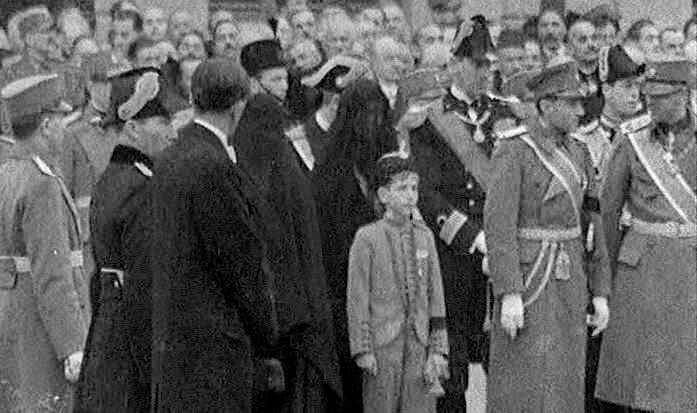
Figure 1.---Prince Peter became king in 1934 after his father King Alexander was assassinated. Here Prince Peter is pictured at the funeral with his mother. |


|
HBC in this section traces the Yugoslavian/Serbian royal family by each individual monarch. This is the format we have followed througout our HBRC site. We include both Serbian and Yugoslav rulers as the Serbian royal family became the royal family of the new Yugsolav kingdom following World War I. The monarchy was terminated by the Communists following Workd War II.
The Byzantium Empire like the Western Roman Empire faced encursions from Barbarian tribes. The first Slav tribal leader to be noted by name was Antis who lived in steppes north of the mouth of the Danube at the beginning of the 6th century. The Slavs for centuries were vassals to the Byzantine Empire. Serbs were recognized as zupans within the Empire.
The Serbs by the second half of the 9th century had been converted to the Orthodox Christianity. Serb Zupans gradually achieved increasing levels of authorities within the Empire. A descendent, Stefan II, became King of Serbia in 1217 and was ancestor of Stefan Dushan (Urosh IV), who proclaimed himself
Emperor of the Greeks and Serbs in 1346 (d 1355), father of the last male of this line, Stefan Urosh V, murdered in 1367.
Stefan II also left an illegitimate son, Vuk, Prince of Zeta, whose great-great-granddaughter Milica mairred Lazar
Grebelyanovich, who deposed Stefan Urosh V and was killed at the Battle of Kosovo Polje 1389 when the Serbs suffered a
disatrous defeat at the hands of Turkish Sultan Murat I.
After the Battle of Kossovo Polje, the Ottomans gradually extended their rule over the Balkans and even threatened Vienna. The Ottomas allowed descendents of Lazar some degree of authority in a much diminsed Serb state. Unlike Christian kingdoms, the Ottomans did not supress other religions. Christain kingdoms repressed Islam and even other Christain denmoinatkions. Jews were barely tolerated in some kingdoms, forced to live in gettos, and expelled or forced to convert in othets. The Ottomans on the other hand, allowed Jews and Christians, the people of the Book, considerable fredom to discretely practice their religions. There were of course many advantages for converting to Islam. One Serbian Prince, Stefan Lazarevic, fights as a vassal of Sultan. Most Serbians remain Christian.
The independence of the southern Slavs had been a dream for the centuries of Ottoman rule, despite their profound religious and cultural difference which continue in the countries formed
from Yugoslavia today. The final steps toward independence from the Ottoman Empire resulted in the establishment of the Karageorgevitch dynasty which is now two centuries old. The dynasty
was established during the Napoleonic era when the map of Europe was being redrawn. A wealthy Serbian clan chief and merchant, Djordje Petrovic--known
to his followers as Karadjordje (Black George, after his dark looks) --led the Serbs in an 1804 uprising against the Ottoman Empire that at the time controlled the Balkans. Karadjordjevic's revolution was successful for a time. He established a government in Belgrade and during 1811 was confirmed as lawful ruler and the
right of succession was vested his family.
The Ottoman Turks returned to Belgrade in 1813. Karadjordje was forced to fled to Austria. His son, Prince Alexander, returned to rule Serbia in 1842, but was deposed in 1858. The independence of the southern Slavs had been a dream for the centuries of Ottoman rule, despite their profound religious and cultural difference which continue in the countries formed from Yugoslavia today. The final steps toward independence from the Ottoman Empire resulted in the establishment of the Karageorgevitch dynasty which is now two centuries old. Actual Serbs founded the two dynasties. Most of the other Balkan kibgdoms that emerged in the 19th century were to have German monarchs. The Karageorgevitch dynasty was established during the Napoleonic era when the map of Europe was being redrawn. The Ottoman did not honor the terms of the Treaty and instead began to forcefully reimpose their rule, even in internal matters. After the assination of Karadjordje, a new leader arose-- Milosch Obrenovich. He founded the next dynasty of Serbian rulers--the Obrenovich. For 200 years these two families competed for the Serbian crown. This is somewhat of an anomaly in royal history because once a royal line isxreplaced, it tends not to return to power.
Yugoslavia was created after World War I around Serbia and other Balkan provinces/pricipalities with Slavic populations (Croatia, Kosovo, Macedonia, Montenegro, and Slovenia). The state was declared the Kingdom of Serbs, Croats and Slovenes in Belgradev (December 1, 1918). The king of Serbia became the monarch of the new state. It was subsequently renamed Yugoslavia. The monarchy was terminated by the Communists following World War II.
Navigate the Boys' Historical Clothing Web Site royal pages:
[Return to the Main Yugoslav page]
[Return to the Main royalty page]
[Austria]
[Belgium]
[Denmark]
[France]
[Germany]
[Italy]
[Italy]
[Luxemburg]
[Monaco]
[Netherlands]
[Norway]
[Romania]
[Russia]
[Spain]
[Sweden]
[United Kingdom]
